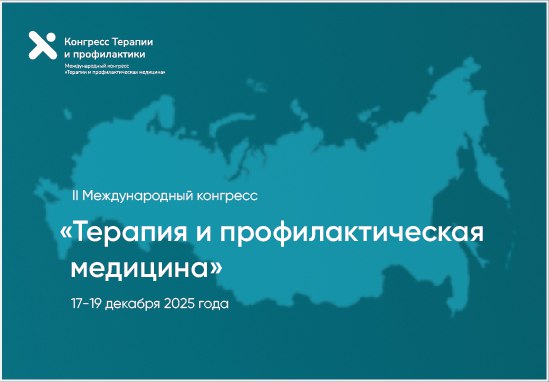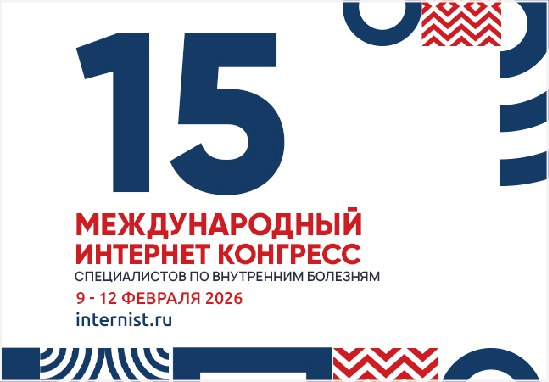Эволюция дислипидемии: от этиологических механизмов к новым мишеням персонализированной профилактической нутрицевтической терапии красным дрожжевым рисом
https://doi.org/10.15829/1728-8800-2019-6-88-98
Аннотация
В обзоре представлен анализ исследований, посвященных роли нутрицевтика армолипида, который сочетает в себе гиполипидемические компоненты красного дрожжевого риса, обладающего статиноподобным действием за счет монокалина К, поликосанола и антиокислители коэнзим Q, астаксантин и фолиевую кислоту, в первичной профилактике сердечно-сосудистых заболеваний. Показана многофакторная эволюция формирования атеросклеротической бляшки на фоне дислипидемии, воспаления и генетических маркеров и аргументирующая целесообразность первичной профилактики. Представленные данные показали, что прием нутрицевтика хорошо переносится и снижает показатели общего холестерина, холестерина липопротеинов низкой плотности, улучшает эндотелиальную функцию сосудистой стенки и снижает маркеры воспаления. Гиполипидемический нутрицевтик можно применять в качестве альтернативного метода первичной профилактики у лиц с низким и пограничным сердечно-сосудистым риском до начала лекарственной терапии статинами, при отсутствии у пациентов приверженности терапии статинами, а также при непереносимости статинов или наличии побочных эффектов.
Об авторах
О. Ш. ОйноткиноваРоссия
Доктор медицинских наук, профессор кафедры терапии факультета фундаментальной медицины МГУ им. М. В. Ломоносова, начальник отдела НИИОЗММ ДЗМ.
Москва.
Тел.: +7 (915) 252-71-77
Е. Л. Никонов
Россия
Доктор медицинских наук, профессор, заведующий кафедрой гастроэнтерологии.
Москва.
Е. В. Крюков
Россия
Доктор медицинских наук, профессор, член-корреспондент РАН, начальник госпиталя.
Москва.
А. П. Баранов
Россия
Доктор медицинских наук, профессор, заведующий кафедрой терапии факультета фундаментальной медицины МГУ им. М. В. Ломоносова; профессор кафедры пропедевтики внутренних болезней и лучевой диагностики РНИМУ им. Н.И. Пирогова МЗ РФ.
Москва.
М. И. Воевода
Россия
Доктор медицинских наук, профессор, академик РАН, директор.
Новосибирск.
Список литературы
1. ВОЗ, Информационный бюллетень, 1 июня 2018 г. https://www.who.int/ru/news-room/fact-sheets/detail/noncommunicable-diseases. Дата доступа: 01.09.2019.
2. Статистическая информация Министерства Здравоохранения РФ: Заболеваемость взрослого населения России в 2016 году, https://www.rosminzdrav.ru/ministry/61/22/stranitsa-979/statisticheskie-i-informatsionnye-materialy/statisticheskiy-sbornik-2016-god. Дата доступа: 01.09.2019.
3. Sanidas E. The role of nutraceuticals in the treatment of primary dyslipidemia. Hellenic Journal of Cardiology. 2018. doi:10.1016/j.hjc.2018.07.009.
4. Муромцева Г. А., Концевая А. В., Константинов В. В. и др. Распространенность факторов риска неинфекционных заболеваний в российской популяции в 2012-2013гг. Результаты исследования ЭССЕ РФ. Кардиоваскулярная терапия и профилактика. 2014; 13(6):4-11. doi:10.15829/1728-8800-2014-6-4-11.
5. Ойноткинова О. Ш., Мамедов М. Н., Цукаева М.Р. и др. Роль суммарного сердечно-сосудистого риска в развитии сахарного диабета у лиц опасных профессий. Вестник новых медицинских технологий. 2017;2:121-9. doi:1012737/article_58f0b7e2b48b63.98497055.
6. Virmani R, Burke AP, Farb A, et al. Pathology of the vulnerable plaque. JACC. 2006;47(8 Suppl):13-8. doi:10,1016/j.jacc.2005.10.065.
7. Stary HC, Chandler AB, Dinsmore RE, et al. A definition of advanced types of atherosclerotic lesions and a histological classification of atherosclerosis: a report from the committee on vascular lesions of the council on arteriosclerosis. Am. Heart Association. Circulation. 1995;92:1355-74.
8. Faxon DP, Fuster V, Libby P, et al. Atherosclerotic Vascular Disease Conference Writing Group III: Pathophysiology. Circulation. 2004;109:2617-25. doi:10.1161/01.CIR.0000128520.37674.
9. Virmani R, Kolodgie FD, Burke AP, et al. Lessons from sudden coronary death: a comprehensive morphological classification scheme for atherosclerotic lesions. Arterioscler Thromb Vasc Biol. 2000;20:1262-75. doi:10.1161/01.ATV.20.5.1262.
10. Hansson GK. Inflammatory mechanisms in atherosclerosis. J Thromb Haemost. 2009;7(Suppl. 1):328-3. doi:10.1111/j.1538-7836.2009.03416.x.
11. Libby P. Inflammation in atherosclerosis. Nature. 2002 Dec. 19-26;420(6917):868-74. doi:101038/nature01323.
12. Petretto E, Liu ET, Aitman T A. gene harvest revealing the archeology and complexity of human disease. Nat Genet. 2007;39:1299-301.
13. Orho-Melander M. Genetics of coronary heart disease: path to etiological mechanisms, new therapy targets and more personalized prevention. J Intern Med. 2015;278:433-46. doi:10.1111/joim.12407.
14. Peters DT, Musunuru K. Functional evaluation of genetic variation in complex human traits. Hum Mol Genet. 2012;21:R18-R23. doi:10.1093/hmg/dds363.
15. Willer CJ, Mohlke K. Finding genes and variants for lipid levels after genome wide association analysis. Curr Opin Lipidol. 2012;23:98-103. doi: 10.1097/mol.0b013e328350fad2.
16. Helgadottir A, Thorleifsson G, Manolescu A, et al. A common variant on chromosome 9p21 affects the risk of myocardial infarction. Science. 2007;316:1491-3. doi:101126/science.1142842.
17. McPherson R, Pertsemlidis A, Kavaslar N, et al. A common allele on chromosome 9 associated with coronary heart disease. Science. 2007;316:1488-91. doi:10.1126/science.1142447.
18. Samani N, Erdmann J, Hall AS, et al. Genomewide association analysis of coronary artery disease. N Engl J Med. 2007;357:443-53.
19. Strong A, Ding Q, Edmondson AC, et al. Hepatic sortilin regulates both apolipoprotein B secretion and LDL catabolism. J Clin Invest. 2012;122:2807-16. doi: 10.1172/JCI63563.
20. Patel KM, Strong A, Tohyama J, et al. Macrophage sortilin promotes LDL uptake, foam cell formation, and atherosclerosis. Circ Res. 2015;116:789-96. doi:101161/CIRCRESAHA.116.305811.
21. Gustafsen C, Kjolby M, Nyegaard M, et al. The hypercholesterolemia-risk gene SORT1 facilitates PCSK9 secretion. Cell Metab. 2014;19:310-8. doi:10.1016/j.cmet.2013.12.006.
22. Hu D, Yang Y, Peng DQ. Increased sortilin and its independent effect on circulating proprotein convertase subtilisin/kexin type 9 (PCSK9) in statin-naive patients with coronary artery disease. Int J Cardiol 2017;227:61-5. doi:10.1016/j.ijcard.2016.11.064.
23. Urban D, Poss J, Bohm M, Laufs U. Targeting the proprotein convertase subtilisin/kexin type 9 for the treatment of dyslipidemia and atherosclerosis. JACC. 2013;62:1401-8. doi:10.1016/j.jacc.2013.07.056.
24. Nozue T, Hattori H, Ogawa K, et al. Effects of statin therapy on plasma proprotein convertase subtilisin/kexin type 9 and sortilin levels in statin-naive patients with coronary artery disease. J Atheroscler Thromb. 2016;23:848-56. doi:10.5551/jat.33407.
25. Oh TJ, Ahn CH, Kim BR, et al. Circulating sortilin level as a potential biomarker for coronary atherosclerosis and diabetes mellitus. Cardiovasc Diabetol. 2017;16:92. doi:10.1186/s12933-017-0568-9.
26. Goettsch С, Kjolby М, Aikawa E. Sortilin and its multiple roles in cardiovascular and metabolic diseases Arteriosclerosis, thrombosis, and vascular biology. 2018;38:19-25. doi.10.1161/ATVBAHA.117.310292.
27. 2018 AHA/ACC/AACVPR/AAPA/ABC/ACPM/ADA/AGS/APhA/ASPC/NLA/PCNA Guideline on the Management of Blood Cholesterol A Report of the American College of Cardiology/American Heart Association Task Force on Clinical Practice Guidelines. JACC. 2019;73(24). doi:10.1016/j.jacc.2018.11.003.
28. 2019 ESC/EAS Guidelines for the management of dyslipidaemias: lipid modification to reduce cardiovascular risk: supplementary data. The Task Force for the management of dyslipidaemias of the European Society of Cardiology (ESC) and European Atherosclerosis Society (EAS). Eur Heart J. 2019;00:1-78. doi:10.1093/eurheartj/ehz455.
29. Adouridis A, Filippatos T, Tsimihodimos V, et al. Combinations of ezetimibe with nonstatin drug regimens affecting lipid metabolism. Expert Rev Cardiovasc Ther. 2011;9:355-66. doi:10.1586/erc.11.4.
30. Burke FM. Red yeast rice for the treatment of dyslipidemia. Curr Atheroscler Rep. 2015;17:495.
31. Corsini A, Bellosta S, Baetta R, et al. New insights into the pharmacodynamic and pharmacokinetic properties of statins. Pharmacol Ther. 1999;84:413-28.
32. Chen CH, Yang JC, Uang YS, et al. Improved dissolution rate and oral bioavailability of lovastatin in red yeast rice products. Int J Pharm. 2013;444:18-24.
33. Zhao SP, Liu L, Cheng YC, et al. Xuezhikang, an extract of cholestin, protects endothelial function through antiinflammatory and lipid-lowering mechanisms in patients with coronary heart disease. Circulation. 2004;110:915-20.
34. Poli A. Primary prevention and hypercholesterolaemia: 'Doc, please, give me the natural statin'. Eur Heart J Supplements. 2019;21 (Suppl. B):B71-2. doi: 10.1093/eurheartj/suz002.
35. Endo A, Kuroda M, Tsujita Y. ML-236A, ML-236B, and ML-236C, new inhibitors of cholesterogenesis produced by Penicillium Citrinum. The Journal of Antibiotics. 1976;29 (12):1346-8. doi:10.7164/antibiotics.29.1346.
36. Kalra EK. Nutraceutical-definition and introduction. AAPS Pharm Sci. 2003;5:E25.
37. Barrios V, Escobar C, Cicero AF, et al. A nutraceutical approach (Armolipid Plus) to reduce total and LDL cholesterol in individuals with mild to moderate dyslipidemia: Review of the clinical evidence. Atherosclerosis. 2017;24(Suppl.):1-15.
38. Cicero AFG, Benvenuti C, ARMoweb study Group. Efficacy of a red yeast rice based nutraceutical in large subgroups of hypercholesterolemic subjects in every day clinical practice. Mediterr J Nutr Metab. 2010;3:239-46.
39. Sola R, Valls RM, Puzo J, et al. Effects of poly-bioactive compounds on lipid profile and body weight in a moderately hypercholesterolemic population with low cardiovascular disease risk: a multicenter randomized trial. PLoS One. 2014;9(8):e101978. doi:10.1371/journal.pone.0101978.
40. Naci H, Brugts JJ, Fleurence R, et al. Dose-comparative effects of different statins on serum lipid levels: a network meta-analysis of 256,827 individuals in 181 randomized controlled trials. Eur J Prev Cardiol. 2013;20:658-70.
41. Weng TC, Yang YH, Lin SJ, et al. A systematic review and meta-analysis on the therapeutic equivalence of statins. J Clin Pharm Therapeut. 2010;35:139-51.
42. Affuso F, Ruvolo A, Micillo F, et al. Effects of a nutraceutical combination (berberine, red yeast rice and policosanols) on lipid levels and endothelial function randomized, double-blind, placebo-controlled study. Nutr Metabol Cardiovasc Dis. 2010;20:656-61.
43. Trimarco V, Battistoni A, Tocci G, et al. Single blind, multicentre, randomized, controlled trial testing the effects of a novel nutraceutical compound on plasma lipid and cardiovascular risk factors: Results of the interim analysis. Nutr Metabol Cardiovasc Dis. 2017;27:850-7.
44. Pisciotta L, Bellocchio A, Bertolini S. Nutraceutical pill containing berberine versus ezetimibe on plasma lipid pattern in hypercholesterolemic subjects and its additive effect in patients with familial hypercholesterolemia on stable cholesterol-lowering treatment. Lipids Health Dis. 2012;11:123.
45. Marazzi G, Pelliccia F, Campolongo G, et al. Usefulness of nutraceuticals (Armolipid Plus) versus ezetimibe and combination in statin-intolerant patients with dyslipidemia with coronary heart disease. Am J Cardiol. 2015;116:1798-801.
46. Marazzi G, Campolongo G, Pelliccia F, et al. Comparison of low-dose statin versus low-dose statin + armolipid plus in high-intensity statin-intolerant patients with a previous coronary event and percutaneous coronary intervention (ADHERENCE Trial). Am J Cardiol. 2017;120:893-97.
47. Marazzi G, Cacciotti L, Pelliccia F, et al. Long-term effects of nutraceuticals (berberine, red yeast rice, policosanol) in elderly hypercholesterolemic patients. Adv Ther. 2011;28:1105-13.
48. Affuso F, Mercurio V, Ruvolo A, et al. A nutraceutical combination improves insulin sensitivity in patients with metabolic syndrome. World J Cardiol. 2012;4:77-83.
Рецензия
Для цитирования:
Ойноткинова О.Ш., Никонов Е.Л., Крюков Е.В., Баранов А.П., Воевода М.И. Эволюция дислипидемии: от этиологических механизмов к новым мишеням персонализированной профилактической нутрицевтической терапии красным дрожжевым рисом. Кардиоваскулярная терапия и профилактика. 2019;18(6):88-98. https://doi.org/10.15829/1728-8800-2019-6-88-98
For citation:
Oinotkinova O.Sh., Nikonov E.L., Kryukov E.V., Baranov A.P., Voevoda M.I. Evolution of dyslipidemia: from etiological mechanisms to new targets of personalized preventive nutraceutical therapy with red yeast rice. Cardiovascular Therapy and Prevention. 2019;18(6):88-98. (In Russ.) https://doi.org/10.15829/1728-8800-2019-6-88-98

























































